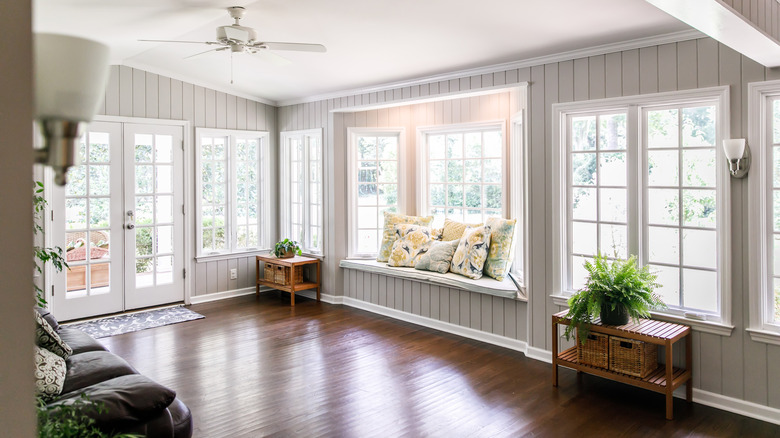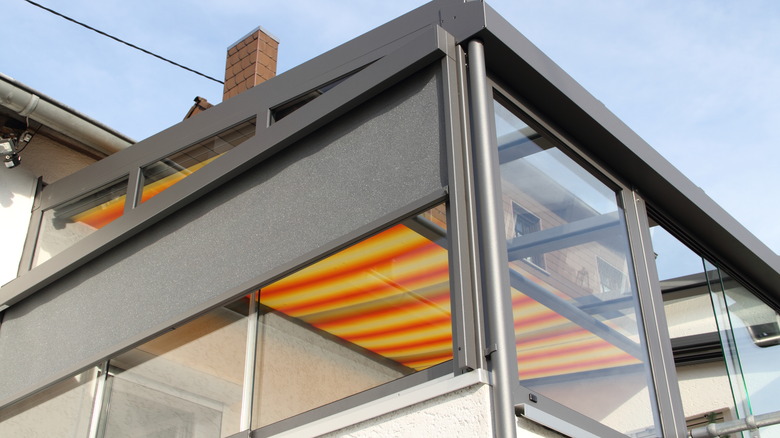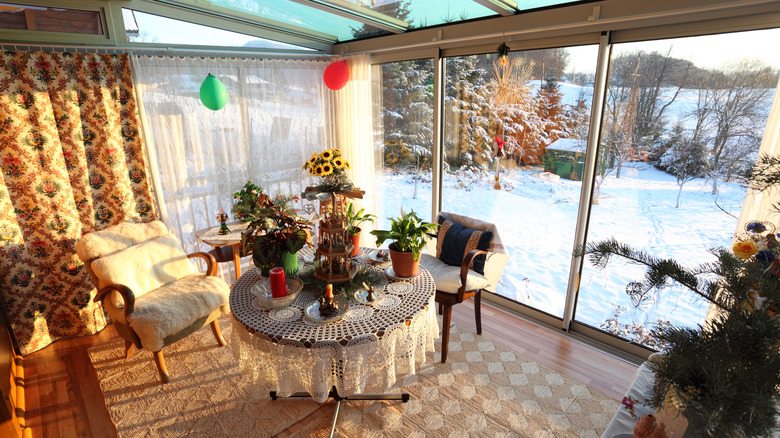Smart Ways To Heat And Cool Your Sunroom In All Seasons
Sunrooms make for a pest-free, sweat-free, and, for the most part, burn-free way to enjoy the outdoors without leaving the comforts of home. It's a space made perfect for people, pets, and plants, particularly those who reside in mild climate areas. The reason for that optimal temperature designation is that most sunrooms are designed as three-season spaces. Such a term means the sunroom's construction plan won't include an HVAC system or any type of insulation. The lack of either inevitably leaves you with a room you'd be hesitant to use if the temperatures outside swing in any extreme direction, be it sweltering hot or blistering cold.
You can alleviate that issue by opting for a four-season sunroom which does include HVAC and insulation. Just know that choice is typically an expensive endeavor. Building a four-season sunroom from the ground up can cost upwards of $80,000, whereas a three-season sunroom falls anywhere between $10,000 and $50,000 depending on the design. Converting a three-season into a four-season will cost a pretty penny, too, and that's true whether you're extending your home's HVAC system or installing a separate one. Luckily, there are cheaper and simpler alternatives. Cooling options include fans, curtains, and window treatments. Options for heating include rugs, portable heaters, and DIY insulation. The right alternative for your three-season sunroom depends on the environment it's creating now, the one you want it to create, and, ultimately, your budget.
How to cool a sunroom
Cooling a sunroom is necessary when living in an extremely hot area. Such a task can seem easier said than done — after all, the main feature of a sunroom is the windows. Yet, it is possible to find some reprieve from the sun's rays if you put in some work around those windows. Perhaps the cheapest solution to cooling this space is tinting them with UV film. This type of film won't dim your outside view, but it will block the rays that heat up your space. Your skin will also thank you for the extra protection. There's also the option of installing blinds or curtains. Though such a feature may obstruct your view, you can always keep them closed during the hottest parts of the day and then open them once the room has cooled.
Solutions that are more expensive and effective are those that increase the air's circulation. A window air conditioning unit would serve this purpose. You'll just want to make sure the window is sturdy enough to hold it. There's also the option of a fan, be it portable or attached to the ceiling. The benefit of a fan is that it can help vent out hot air, especially when paired with an operable skylight. The average installation cost for the latter is somewhere between $1,000 and $2,500.
How to heat a sunroom
Insulation is the absolute most vital improvement you can implement if your main goal is to retain warmth in your sunroom during the long winter months. Without insulation, any other efforts to create heat will slip out into the cold. Similarly, a properly insulated sunroom will stay cooler longer when a lower interior temperature is your desired outcome.
Those looking to remodel a sunroom can opt to insulate the floors or walls during the process. A much simpler solution is to install weather stripping around the windows, lay down rugs, or hang up heavy curtains. Once these are in place, you can add a space heater or electric fireplace to generate warmth. The use of a space heater does come with a caution warning. If you're uneasy with such an appliance, you could opt for baseboard heaters. It'll take more effort and money to install, but baseboard heaters are much safer and more energy-efficient. They also blend nicely without taking up space. You'll also want to check the windows in your sunroom. Most newer designs incorporate dual panes. Older ones could still be sporting the single version, and if this is the case, investing in an upgrade can make a world of difference. Another option that likely warrants the use of a professional is the installation of a mini-split, or ductless, system. Though most are designed to only cool or heat, you can find premium options that perform both tasks.


